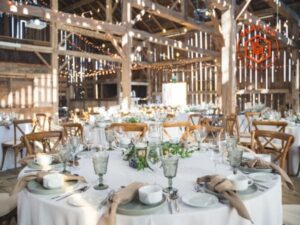Maximizing Small Spaces for Memorable Events
Written by: Marcelo Flores
Maximizing a small venue requires creativity and smart planning. In this guide, we’ll explore how you can transform a limited space into a perfect setting for various events, such as birthdays, small meetings, and baby showers. Learn to see the potential in small spaces and turn them into cozy, memorable, and functional event locations.
Table of Contents
1. Assessing Your Venue’s Potential
2. Creative Layout and Space Optimization
4. Tailoring Events to Fit Small Venues
5. Marketing Small Venues for Specific Events
1. Assessing Your Venue’s Potential

When dealing with a small venue, the key to successful event planning lies in a thorough assessment of its potential. This is not just about recognizing the limitations of the space, but also about uncovering opportunities to maximize its use. Here are some essential steps and considerations for assessing a small venue:
Understand the Space Layout
- Dimensions and Shape: Measure the dimensions of the space to understand what you’re working with. The shape of the room – whether it’s square, rectangular, or otherwise – can significantly influence how the space can be utilized.
- Fixed Elements: Note any fixed elements such as pillars, stages, or built-in bars. These elements can either become focal points or areas to work around when planning your layout.
Evaluate Flexibility
- Furniture and Equipment: Assess the available furniture. Are there pieces that can be moved or removed to create more space? Is there equipment available on-site, or will you need to bring in additional items?
- Adaptability for Different Layouts: Consider how flexible the space is for various layouts. Can it accommodate theater-style seating, round tables, or a cocktail setup?
Assess Comfort and Safety
- Capacity Limits: Adhere to capacity limits for safety and comfort. Overcrowding can quickly turn an event from cozy to uncomfortable.
- Climate Control: Ensure the venue has adequate heating, cooling, or ventilation to keep guests comfortable throughout the event.
2. Creative Layout and Space Optimization

In small venues, every inch counts. Optimizing your space with a creative layout not only maximizes functionality but also enhances the overall aesthetics and flow of your event. Here’s how to utilize every part of your venue efficiently:
Efficient Space Utilization
Focus on selecting pieces that are sleek yet functional. Opt for slim-profile chairs that are both comfortable and space-efficient. This helps in creating an open, airy feel, even in confined spaces. Arrange seating and tables in a way that encourages conversation and interaction, yet allows for unobstructed movement.
Circular tables, for instance, can often fit more guests into a smaller area than rectangular ones would allow.
Maximizing Vertical Space
When the floor space is all taken up, remember that walls and ceilings offer untapped potential. Consider using the ceiling for hanging decor, like lights or floral pieces, to draw the eye up and create a feeling of more space. If you are going to do that, don’t overdo it with the decoration, you don’t want your guests to feel visually overwhelmed.
Flow and Functionality
It’s crucial to maintain clear pathways for guests to move around easily, which helps in managing the event’s flow and avoiding congested areas. Also, keep the guests away from the wall, this way, your space will feel bigger.
3. Choosing the Right Decor

The decor in a small venue can have a significant impact on the perception and ambiance of the space. When chosen wisely, it can make a small area feel more spacious and welcoming. Here are key considerations for selecting decor that maximizes the potential of a small venue:
Opt for Minimalist Themes
Simplicity is Key. A minimalist approach can help prevent a small space from feeling cluttered. Choose simple yet elegant decor that complements the space without overwhelming it.
Use Light Colors and Mirrors
Opting for a light color palette makes spaces feel more open and airy. Light hues reflect more light, which can visually expand the area.
Mirrors are another fantastic tool. They reflect both natural and artificial light, making the venue seem twice its actual size. Strategically placed mirrors can also reflect key decorative elements, doubling their impact and enhancing the venue’s overall aesthetic.
Combining light colors with mirrors is an effective way to create an illusion of space. This technique allows for a broader scope of decorative themes and styles, enabling event planners to achieve their vision without the constraints of a small venue.
Maximize Wall Space
Leveraging wall space effectively can transform the perception of a small venue, making it feel larger and more inviting. By selecting art pieces, mirrors or decorative items that resonate with the theme of your event, you can draw attention upwards, creating a more spacious feel.
For themed events like baby showers, consider wall decorations that match the theme, adding to the event’s ambiance without crowding the area.
4. Tailoring Events to Fit Small Venues

Adapting your event to fit a small venue is crucial for its success. By customizing the event setup to suit the constraints of the venue, you can create a memorable experience that feels intimate and personalized rather than restricted. Here are strategies to tailor different types of events to small spaces:
Adapting to the Venue’s Unique Characteristics
First, assess the unique features of your venue. Identify any architectural details, natural light sources, or existing decor elements that can be incorporated into your event design. Use these characteristics to your advantage by designing your event layout and activities around them, enhancing the venue’s charm and functionality.
Design for the Event Type
Adjust your setup based on the event. Social events like parties might benefit from open, flexible seating to encourage mingling, while workshops or meetings may require a more structured layout. Opt for furniture that’s both stylish and practical, ensuring it serves multiple purposes to save space.
Lots of small venues have focused their efforts on hosting baby showers and birthday parties because they are typically smaller, more intimate events.
5. Marketing Small Venues for Specific Events

Identify Your Niche
Knowing the types of events your small venue is capable of hosting is the first step to effective marketing. Whether it’s intimate weddings, corporate meetings, bay showers or other social gatherings, identifying your niche allows you to tailor your marketing efforts directly to the clients who are searching for exactly what your venue offers.
Consider creating targeted marketing campaigns that speak directly to the needs and desires of these specific groups, highlighting the unique benefits your venue provides for their type of event.
Utilize Social Media and Digital Marketing
Social media platforms are invaluable tools for showcasing the versatility and charm of your venue to a wide audience. Create engaging content that highlights past events, showing potential clients the various ways the space can be transformed to suit different themes and occasions. Utilize before-and-after shots, video testimonials, and event highlights to create a dynamic portrayal of your venue in action.
Implement targeted advertising campaigns on platforms like Instagram and Facebook to reach audiences specifically looking for venues for intimate weddings, corporate gatherings, or other niche events.
Collaborate with Local Vendors
Building relationships with local event vendors can create a mutually beneficial marketing ecosystem. By partnering with caterers, florists, photographers, and event planners, you can offer comprehensive package deals that make planning easier for your clients. These partnerships also open up opportunities for cross-promotion, where each vendor markets the venue to their clientele.
Highlight Flexibility and Personalization
Emphasizing your venue’s ability to adapt to different event needs and personalization options can make your space more appealing to potential clients. Showcase a variety of event setups and themes that your venue has successfully accommodated, demonstrating your team’s flexibility and creativity.
Leverage SEO and Local Listings
Optimizing your online presence for search engines is crucial for making your venue easily discoverable by potential clients. Implement an SEO strategy that targets keywords related to small venues and the specific types of events you cater to. Ensure your venue is accurately listed on local business directories and event planning platforms, complete with compelling photos, descriptions, and contact information. Regularly updating your listings and encouraging reviews from past clients can also improve your visibility and appeal to those searching for the perfect small venue for their event.
In conclusion, transforming a small venue into a captivating event space is all about creativity, strategic planning, and smart marketing. By assessing the venue’s potential, optimizing space with creative layouts, selecting the right decor, and tailoring events to fit the venue’s unique charm, you can host memorable gatherings that exceed expectations. Embrace the advantages of small venues, such as their ability to create intimate and personalized experiences, and leverage them through targeted marketing strategies.
Remember, the key to success lies in understanding your space’s potential and marketing it effectively to attract the right events. With these strategies, your small venue can host big, unforgettable events.








